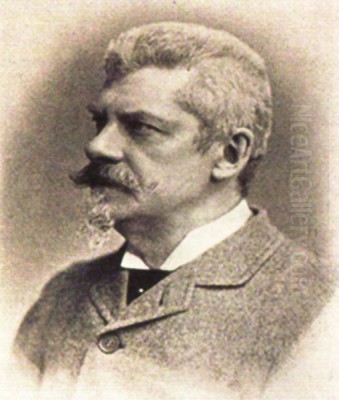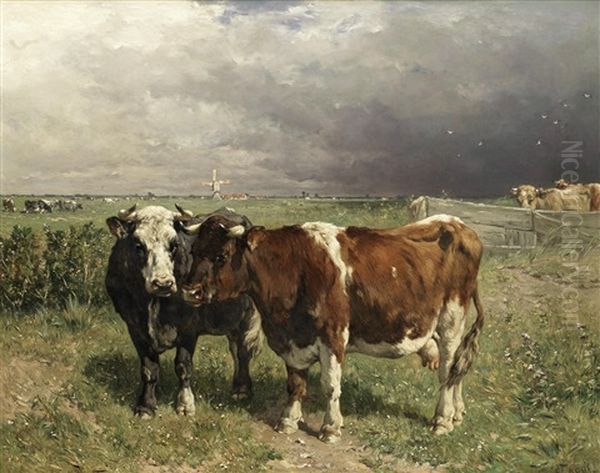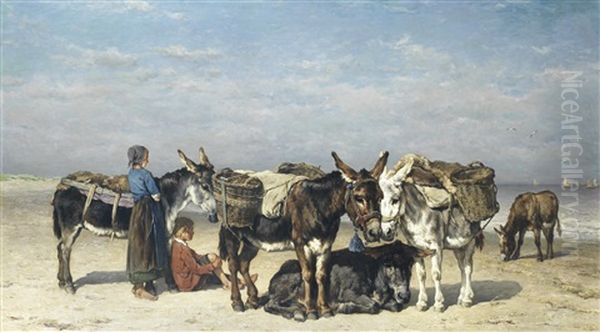
Johannes Hubertus Leonardus de Haas stands as a significant, albeit sometimes considered peripheral, figure associated with the renowned Hague School of Dutch painting. Born on March 25, 1832, in Hedel, Gelderland, in the Netherlands, he dedicated his artistic career primarily to the depiction of animals, particularly cattle, within natural landscapes. His work forms part of the rich tapestry of 19th-century Dutch art, a period marked by a resurgence of realism and a deep appreciation for the native countryside. De Haas passed away on April 8, 1908, in Königswinter, Germany, leaving behind a legacy captured in canvases known for their warmth, vitality, and connection to the Dutch artistic tradition.
Early Life and Artistic Formation
De Haas's journey into the world of art began formally at the prestigious Koninklijke Akademie van Beeldende Kunsten (Royal Academy of Art) in Amsterdam. This institution was a cornerstone of artistic education in the Netherlands, providing foundational training for many aspiring painters. Seeking more specialized guidance, particularly in the genre that would define his career, de Haas moved to the city of Haarlem.
In Haarlem, he entered the tutelage of Pieter Frederik van Os (1808–1892). This was a pivotal step, as van Os was himself a respected painter known for his landscapes and animal subjects, continuing a family tradition – his father, Pieter Gerardus van Os (1776–1839), was also a celebrated painter, particularly noted for his depictions of cattle, echoing the legacy of Dutch Golden Age masters like Paulus Potter (1625–1654). Studying under Pieter Frederik van Os provided de Haas with direct access to the techniques and thematic concerns central to Dutch animal and landscape painting.
The Oosterbeek Influence
Around 1855, de Haas spent time working in Oosterbeek, a village near Arnhem that had gained a reputation as the "Dutch Barbizon." Like its French counterpart near the Forest of Fontainebleau, Oosterbeek attracted artists seeking to escape urban confines and engage directly with nature. They aimed to capture the local landscape and rural life with greater realism and atmospheric sensitivity than academic conventions typically allowed.

During his time in Oosterbeek, de Haas interacted with other artists who were instrumental in shaping the direction of Dutch landscape painting. Among them were Gerard Bilders (1838–1865), a promising young painter whose work emphasized mood and tone, and Anton Mauve (1838–1888), who would later become a leading figure of the Hague School and a cousin-in-law to Vincent van Gogh. The exchange of ideas and the shared focus on direct observation of nature in Oosterbeek undoubtedly influenced de Haas's developing style, reinforcing a commitment to realism infused with atmospheric feeling. Other artists associated with Oosterbeek included Johannes Warnardus Bilders (father of Gerard) and early pioneers like Willem Roelofs (1822–1897).
Mature Style: Animals, Landscapes, and Light
Johannes Hubertus Leonardus de Haas became particularly renowned for his skill in depicting cattle. His paintings often feature cows grazing peacefully in meadows, resting near water, or being tended by pastoral figures. These scenes are rendered with a keen eye for animal anatomy and behaviour, capturing the placid yet vital presence of the creatures within their environment. His work continued the strong Dutch tradition of animal painting, bringing it into the context of 19th-century realism.
His style is often characterized by a warm and vivid color palette, which could sometimes distinguish his work from the more typically muted or tonal approaches favoured by some core Hague School members. While influenced by the French Barbizon School – artists like Jean-Baptiste-Camille Corot, Jean-François Millet, Théodore Rousseau, and the animal painter Constant Troyon – de Haas, like many Dutch contemporaries, adapted these influences to a distinctly Dutch sensibility. The emphasis was often on capturing a specific mood or impression, conveying the tranquil atmosphere of the Dutch countryside through careful attention to light and its effects on the landscape and the animals within it. His paintings sought to communicate an emotional connection to the scene rather than merely documenting its appearance.
Connection to the Hague School
De Haas is consistently associated with the Hague School, a movement flourishing roughly between 1860 and 1890. Centered primarily in The Hague, this group of artists shared a commitment to realism and a focus on depicting Dutch landscapes, coastal scenes, peasant life, and cityscapes with an emphasis on atmosphere and light, often employing tonal palettes. Key figures included Jozef Israëls (1824–1911), Jacob Maris (1837–1899), his brother Willem Maris (1844–1910) – also famous for his depictions of cattle and ducks near water – Anton Mauve, and the seascape painter Hendrik Willem Mesdag (1831–1915).

While de Haas shared the realist concerns and often the subject matter (especially landscapes with cattle) of the Hague School, he is often described as a peripheral figure. This might be due to stylistic nuances, such as his sometimes warmer palette, or perhaps his extended periods working outside The Hague, including his time in Haarlem, Oosterbeek, and later Brussels. Nevertheless, his connections were strong. He was a student of Pieter Frederik van Os, whose influence permeated the realist landscape tradition. In Haarlem, he formed close associations with fellow van Os students Paul Gabriël (1828–1903), who became known for his light-filled landscapes, and Hendrik Dirk Kruseman Van Elten (1829–1904), who later found success in America. These personal and educational ties firmly place him within the network that nurtured the Hague School's development.
Career Development and Recognition
De Haas achieved considerable recognition during his lifetime. A significant early honour came in 1861 when he was awarded a gold medal for a work exhibited at an art exhibition in Utrecht. This award signaled his rising prominence within the Dutch art world. His reputation was not confined to the Netherlands; like many successful artists of his time, he likely participated in international exhibitions, bringing his depictions of Dutch pastoral life to a wider audience.
His paintings found favour with collectors, both public and private. The presence of his works in auction catalogues, such as those from Bonhams, and their documented sale prices – for instance, a Cattle in a pasture estimated at £6,000-£8,000 in a past sale – attest to a sustained market interest. This indicates that his realistic yet atmospheric portrayals of animals and landscapes resonated with the tastes of the period. For much of his active career, from around 1857 onwards, de Haas lived and worked in Brussels, Belgium, while maintaining strong ties to the Dutch art scene.
Representative Works
While a comprehensive catalogue raisonné might be extensive, several works exemplify de Haas's typical subjects and style:
_Hirtin met rindern op de weide_ (Shepherdess with Cattle in the Meadow): Dated 1880, this oil painting (48 x 83 cm) likely depicts a classic pastoral scene. One can envision a composition featuring cattle grazing under the watchful eye of a shepherdess, set within a characteristically Dutch meadow, perhaps under a luminous sky. It showcases his focus on the harmonious relationship between humans, animals, and the landscape.
_Cattle in a pasture_: This title represents a recurring theme in his oeuvre. A work with this title, measuring 79 x 100 cm, would typically feature one or more cows, rendered with anatomical accuracy, situated within a detailed pasture setting. Emphasis would likely be placed on the play of light across the animals' hides and the surrounding foliage, creating a sense of calm and naturalism.
_Waiting for the catch_: This larger painting (95 x 162 cm) suggests a slightly different theme, perhaps incorporating figures near water, possibly fishermen or people waiting by boats. While still likely a landscape, the title implies a narrative element and potentially a coastal or river scene, broadening the scope beyond purely pastoral subjects, though animals might still feature.
These examples highlight his dedication to animal painting, particularly cattle, within realistic landscape settings, imbued with the atmospheric qualities characteristic of his style and the broader influences of Dutch realism and the Hague School.
Later Life and Legacy
Johannes Hubertus Leonardus de Haas spent his later years in Königswinter, a town in Germany on the Rhine River. He died there in 1908. His life spanned a period of significant evolution in European art, witnessing the rise of Realism, the influence of the Barbizon School, and the flourishing of the Hague School in his native Netherlands.
His legacy lies in his contribution to the Dutch tradition of animal and landscape painting. He successfully merged the detailed observation inherited from Golden Age masters like Potter with the 19th-century realist emphasis on atmosphere, mood, and the direct study of nature. While perhaps not as central to the Hague School narrative as figures like Israëls or Mauve, his work consistently found an appreciative audience and holds a secure place within the story of Dutch art during this era. His paintings continue to be valued for their skillful execution, their evocative portrayal of rural life, and their warm, engaging connection to the natural world.
His works are held in public collections, notably the Museum Boijmans Van Beuningen in Rotterdam, ensuring that his contribution to Dutch art remains accessible. He remains an important figure for understanding the breadth of the Hague School's influence and the enduring appeal of realistic animal and landscape painting in the Netherlands.
Conclusion
Johannes Hubertus Leonardus de Haas was a dedicated and skilled Dutch painter whose life's work centered on the depiction of animals, especially cattle, within the landscapes of his homeland and beyond. Educated in Amsterdam and Haarlem under Pieter Frederik van Os, influenced by the Oosterbeek artists and the French Barbizon school, and closely associated with the Hague School, he forged a distinct style characterized by realism, warmth, and atmospheric sensitivity. Through works like Hirtin met rindern op de weide and numerous scenes of Cattle in a pasture, he contributed significantly to the 19th-century revival of Dutch landscape and animal painting, earning recognition during his lifetime and securing a lasting place in collections and art historical narratives. His art serves as a testament to the enduring beauty found in the pastoral scenes and animal life of the Netherlands.